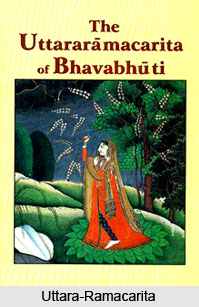 Bhavabhuti was a Sanskrit dramatist of seventh to eighth century. He was celebrated in Indian traditions as a playwright equal to Kalidasa. That means his plays are considered equivalent to the works of Kalidas. In many places he has written Srikantha Nilakantha as his real name. He was the son of Nilakantha and Jatukarni who was born at Padmapura in the Vidarbha region of interior Maharashtra. Bhavabhuti belonged to a respected Brahman family of the Vedic tradition. Scholars believe that he became court poet of Kanyakubja. In later day it was popular in the name of Kanauj that is present in Uttar Pradesh.
Bhavabhuti was a Sanskrit dramatist of seventh to eighth century. He was celebrated in Indian traditions as a playwright equal to Kalidasa. That means his plays are considered equivalent to the works of Kalidas. In many places he has written Srikantha Nilakantha as his real name. He was the son of Nilakantha and Jatukarni who was born at Padmapura in the Vidarbha region of interior Maharashtra. Bhavabhuti belonged to a respected Brahman family of the Vedic tradition. Scholars believe that he became court poet of Kanyakubja. In later day it was popular in the name of Kanauj that is present in Uttar Pradesh.
He received his education at `Padmapawaya`. This was a place at the distance of 42 km of Gwalior. He composed his historical plays at `Kalpi i.e. a place on banks of river Yamuna. In Malati-Madhava i.e. a prakamna in ten acts, he describes the love between Malati and Madhava. Malati was a daughter of a minister in Avanti and Madhava was a young scholar in Ujjayini and son of a minister in another state. The king desires that his minister`s daughter Malati marry a youth called Nandana. Malati is in love with Madhava ever since she saw him and drew his portrait. Madhava reciprocates, and draws a portrait of her in turn. Malati suspects her father`s motives in falling in with the King`s plans for her. Their story is interwoven with that of Makaranda, Madhavas friend, and Madayantika, a sister of the king`s favourite. Makaranda, disguised as Malati, goes through a wedding ceremony with the groom chosen by the king for Malati. Assisted by a nun, Malati and Madhava are united. And thus after numerous travails, all ends well, with the two couples uniting. The theme is new, as well as the treatment of the plot.
Bhavabhuti`s two other plays emanate from the Ramayana. Mabaviracarita i.e. `Exploits of the Great Hero` dramatizes Rama`s deeds up to his victory over Ravana and the return of Rama and Sita to Ayodhya. Uttara-Ramacarita i.e. `Rama`s Later Exploits` is in seven acts that present the main events of the Uttarakanda, or `Later Book`, of the Ramayana. It changes the epic`s sad ending, where the couple is separated, into a happy denouement. Thus, after Rama recognizes his sons at the moment when they recite for him the Ramayana, it depicts on the occasion of a play-within-the-play filled with adbhuta rasa, the union of Rama and Sita, once the people have accepted her innocence.
These two works especially Uttara-Ramacarita, offer evidence of Bhavabhuti`s vigorous language, elaborate and expressive rather than suggestive descriptions, and powerful characterization. Rama and Sita, Vasanti and Atreyi, Lava and Kusa, Lava and Chandraketu, Janaka and Valmiki, Kausalya and Arundhati, Prithvi and Ganga, all offer strong contrasts as well as symmetry in their portrayals. Abounding in karuna rasa or pathos, Uttara-Ramacarita is unique as a nataka filled with epic qualities, presenting life in its diverse dimensions of love, tragedy, remorse, conflict, and unexpected turns in the course of destiny.
While tradition rightly compares Uttara-Ramacarita with Kalidasas plays in poetical and dramatic excellence, one should emphasize that Bhavabhuti has his own distinct way of expression as well as writing, and his works offer an alternative style of Sanskrit theatre. This gives a predominant place to the vacika, or verbal aspect as well.




















